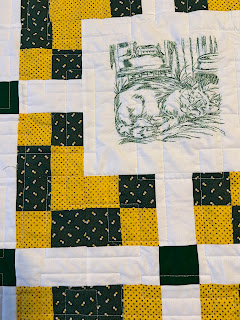Jacket 7 - Finishing
The finishing steps are mostly completed by hand. The jacket undercollar is cut from pre-made collar fabric. This is a combination of wool felt for the right side and hair canvas pad-stitched to it for the wrong side (Picture 7-1).
The hair canvas was applied on the bias, so when I cut the under collar, I had the bias grain line on the pattern follow that of the canvas. The seam allowances on the under collar are removed. This is a little tricky and I later had to adjust the under collar to fit the upper collar. After the under collar is trimmed it is folded and steamed on the fold line using a ham to shape it (Picture 7-2).
I had read up on grading seams before I trimmed the front
seams. The advice was to trim the seam
allowance closest to the body to the smallest amount and trim other seam
allowances in layers. I did this on the
front – it was easy to tell which side of the front would be closest to the
body. I was less sure with the
collar. In retrospect, the neckline seam
allowance of the jacket is closer to the body than the collar seam allowance
when in the wearing position.
The collar is on after some self-infected difficulties. The neckline seam of the lining and facing
are slipped stitched in place. It all
fits nicely together. I had been
concerned about needing to open the lapel seam at the top where it joins the
collar if it didn’t fit. So, I didn’t
back stitch with the result that those seams began to pull open from all the
handling. More thread and tiny stitches
to complete those seams.
The lower hem is easy because of the early preparation of
the jacket fronts and back. Before
assembling the fronts and back, I applied the hem interfacing using catch
stitches along the hem line. All I had
to do now, was turn up the hem along the interfacing, press, and catch stitch
in place.
Now for the buttonholes.
This could be a make-or-break point for the jacket. I am using machine made buttonholes. I am not confident in the quality of my bound
buttonholes, but I am confident that my sewing machine makes great
buttonholes. To start, I decide to do a
refresher on making machine buttonholes.
I found an article by Louise Cutting at Threads which was very helpful.
(https://www.threadsmagazine.com/project-guides/fit-and-sew-tops/making-pretty-buttonholes) In addition
to the usual care in placement and choice of size, she suggested using
water-soluble stabilizer under and on top of the buttonhole. I have used paper stabilizer under
buttonholes to help keep the zigzag stitches even. Using water-soluble stabilizer for
buttonholes was new to me and worked well.
She also suggested using a small amount of Fray Check between the “legs”
of the buttonhole on front and back.
This keep the fabric from shredding as the buttonhole is opened. This also worked well.
I did eight practice buttonholes to test size and thread (Picture 7-3).
The thread I used to construct the jacket seem too light for the buttonholes; black sewing thread was too dark; the Tire Silk Threads #50 in color #66 black-brown (Superior Thread) was the best match when used with black sewing thread in the bobbin. My husband liked the keyhole style but the ones I made using the actual jacket button (1 inch or 25mm) as the measurement produced a buttonhole that was tight. I found a slightly larger button (27mm) in my collection and use this for the sewing machine to measure the buttonhole length. The button slipped through the latter buttonhole easily without too much extra space. So, the buttonholes are 27mm in Tire black-brown thread on the right side and black sewing thread in the bobbin for the wrong side. I made three buttonholes on the jacket – two on the left front and one on the right for the inside button with Solvy stabilizer on top and bottom. (Picture 7-4)
The lining is slipped stitched in place at the cuffs and lower hem. Placement of the lining on the lower hem took some fussing so that the lining length matched the jacket and fit smoothly. Finally, the buttons are sewn on – the four outside buttons I did on the sewing machine and the inside button I did by hand.
Finished! In my next
blog about the jacket, I will have a picture of the completed jacket and some
final thoughts on the construction and tools I used.
*Note - This is the 7th in a series of posts by Sandy Herman about making a man's tailored jacket.






Comments
Post a Comment